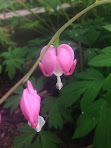Discover the Beauty of Shade-Loving Flowers
Introduction:
If you have a shaded garden or a space with limited sunlight, there are several shade-loving flowers that you can consider planting. These flowers are adapted to thrive in low-light conditions. Here are some tips on how to make a shade-loving flower garden:
<script async src="https://pagead2.googlesyndication.com/pagead/js/adsbygoogle.js?client=ca-pub-2985789920568613" crossorigin="anonymous"></script>
Know Your Shade:
Different plants have varying shade preferences. Some thrive in dappled shade, while others prefer deep shade. Understand the type and intensity of shade in your garden before selecting plants.
Choose the Right Plants:
Opts for flowers that are known for their shade tolerance. Some popular shade-loving flowers include-
Hostas: Among perennials that prefer the shade, this one is the most widely used. The main characteristic of the different types of Hosts is their variety in foliage. Hosta produces tiny, lily-shaped blooms that are either purple or white in color.
<script async src="https://pagead2.googlesyndication.com/pagead/js/adsbygoogle.js?client=ca-pub-2985789920568613"
crossorigin="anonymous"></script>
Impatiens: The genus Impatiens/Touch-me-not has more than a thousand species of blooming plants that are extensively found in the tropics and Northern Hemisphere. Impatiens thrive in damp environments. Ideally, a site should receive two to four hours of filtered sunlight during the day, or morning sun and afternoon shade. Growing impatiens in deep shade is another option. However, in areas with significant shadows, plants will grow taller and produce fewer flowers.
Lungwort (Pulmonaria): These perennials grow in clumps or rosettes and are either evergreen or herbaceous. Their hair varies in length and stiffness, covering them completely. Lungwort treats for stomach and intestinal illnesses, kidney and urinary tract infections, fluid retention and TB. It facilitates the opening of airways and the removal of accumulated mucus from the lungs.
Begonias: Begonias has more than 2,000 distinct plant species. Native to damp subtropical and tropical areas, begonias Certain species are frequently grown as decorative houseplants indoors. Certain begonias, such as wax begonias and the more recent hybrid varieties, will bloom nonstop all summer long. They work well in window boxes, hanging baskets, and other containers in addition to being bedding plants.
Ferns: A class of vascular plants known as ferns reproduce by spores; they do not have seeds or flowers. They are not like mosses in that they have vascular life cycles, meaning that the branching sporophyte is the predominant phase, and they have specialized tissues that carry nutrients and water. Historically they have been utilized in numerous ways by humans, including as ornamental plants, domestic items, meals, and in handicrafts. They have also been used as medicinal plants.
Foxglove: Digitalis is a genus of about 20 species of herbaceous perennial plants, shrubs, and biennials, commonly called foxgloves. Shade gardens must include these towering spires of bell-shaped blooms. It is customarily utilized as a culinary component. Foxglove leaves contain cardiac glycosides, primarily digitoxin, which makes them toxic to humans and potentially deadly if consumed.
Bleeding Heart: Dicentra/Bleeding Heart a genus of eight species of herbaceous plants native to eastern Asia and North America, is commonly referred to as bleeding hearts. The plants have strangely formed blooms and finely divided leaves.
Foam Flower: A small compact shade-loving plant that is cold-hardy and flowers in early spring. Fine green leaves and clumps of brushy, foamy-looking. The plant grows to a height of one foot and produces a white blossom in April and May. It grows best in medium to dry soil, partial sun to full shade, and loam or sand.
Hydrangea: Hydrangea, commonly named Hortensia, is a genus of more than 70 species of flowering plants native to Asia and the Americas. Naturally occurring pH sensors are hydrangeas. In acidic soil, their blossoms become blue; in alkaline soil, they turn pink. This is why the Hydrangea is sometimes referred to as the "Change Rose."
Caladium: Araceae is a family of flowering plants that includes the genus Caladium. Common names for them include "elephant ear," "Jesus heart," and "angelic wings. "They thrive in heat and humidity and are utilized throughout the state as bedding plants, borders, or pots to add summer color to gloomy areas. Plowed in a hayrack, a mixture of ´Moonlight´ and ´Strawberry Star´ caladiums (Caladium bicolor) creates a lovely display.
Provide Adequate Moisture:
Many shade-loving plants prefer consistently moist soil. Water them frequently, especially in the dry seasons. Mulching can help retain moisture.
Improve Soil Quality:
Work on improving the soil in your shaded area. Add organic matter like compost to enhance soil structure and fertility.
Consider Container Gardening:
If your garden doesn't have suitable soil conditions, consider planting shade-loving flowers in containers with well-draining soil. This allows you to control the soil quality more effectively.
Choose the Right Time for Planting:
Planting at the right time is crucial for the success of your garden. In general, early spring or fall is a good time for planting, as the weather is cooler, and plants can establish themselves more easily.
Prune and Divide:
Regular pruning can help control the size and shape of your shade-loving plants. Some plants benefit from dividing every few years to rejuvenate them and promote healthy growth.
Fertilize Appropriately:
Use a balanced, slow-release fertilizer to provide essential nutrients for your shade-loving plants. Observe the suggested application amounts listed on the packaging for the fertilizer.
Monitor for Pests and Diseases:
Watch out for common diseases and pests in your garden. Early detection and treatment can prevent problems from spreading.
Experiment and Enjoy:
Gardening is a learning process. Experiment with different combinations of shade-loving plants and enjoy the unique beauty they bring to your shaded space.
Remember to check the specific care requirements for each type of flower you choose, as individual species may have specific needs.











.jpg)
.jpg)